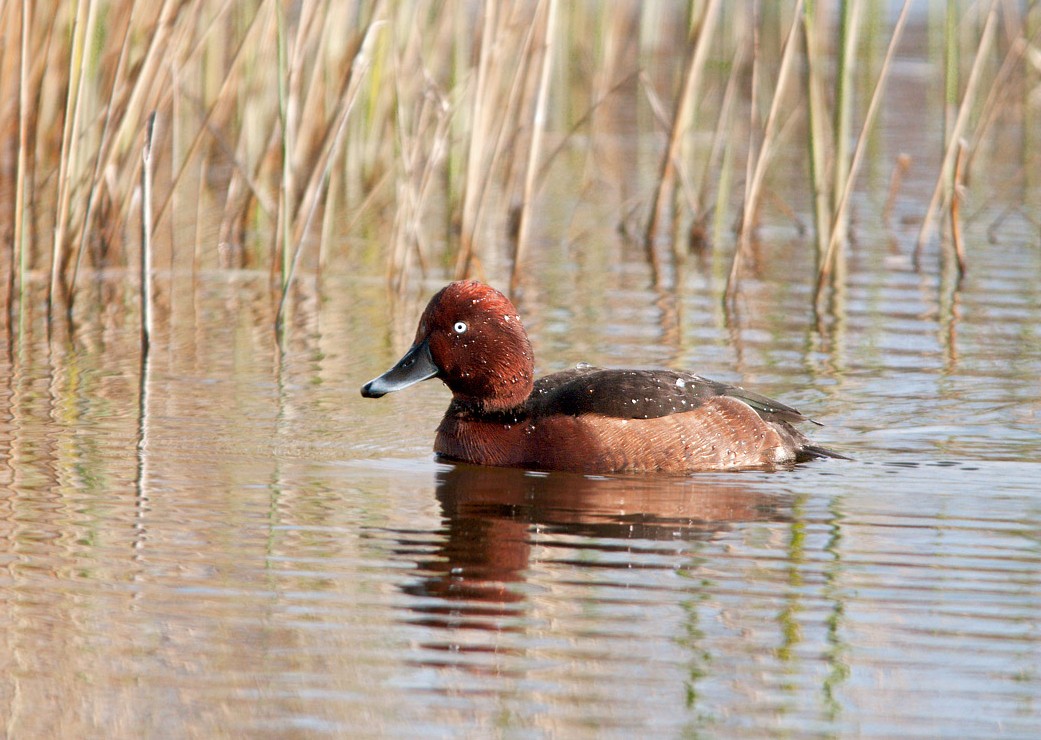Ferruginous Duck
A species of Diving ducks Scientific name : Aythya nyroca Genus : Diving ducks
Ferruginous Duck, A species of Diving ducks
Botanical name: Aythya nyroca
Genus: Diving ducks
Content
Description General Info
 Photo By Alessandro Musicorio , used under CC-BY-SA-2.0 /Cropped and compressed from original
Photo By Alessandro Musicorio , used under CC-BY-SA-2.0 /Cropped and compressed from original Description
The breeding male is a rich, dark chestnut on the head, breast and flanks with contrasting pure white undertail coverts. In flight the white belly and underwing patch are visible. The females are duller and browner than the males. The male has a yellow eye and the females have a dark eye. 
Size
42 cm
Colors
Brown
Black
Red
Gray
White
Life Expectancy
8 years
Nest Placement
Ground
Feeding Habits
Ferruginous Duck primarily consume aquatic vegetation, molluscs, insects, and fish, foraging via diving or dabbling, often nocturnally. They exhibit a preference for either upending or a characteristic diving technique to obtain food.
Habitat
The ferruginous Duck favors shallow freshwater habitats such as marshes and pools surrounded by dense aquatic vegetation, including reeds and willows. Preferred environments also encompass well-vegetated saline and brackish lakes during breeding. It inhabits various water bodies from lowlands to high altitudes up to 4200 meters, and while migrating or in winter, it can be found in coastal areas and larger lakes.
Dite type
Aquatic invertebrate eater
General Info
Feeding Habits
Bird food type
Distribution Area
The breeding range of the ferruginous duck is from Iberia and the Maghreb east to western Mongolia, south to Arabia, although in the west is now scarce and localised and locally extirpated in some countries. The duck winters throughout the Mediterranean Basin and the Black Sea, smaller number migrate into sub-Saharan Africa via the Nile Valley. Eastern birds winter in south and south-east Asia. 
Species Status
The species is threatened by the degradation and destruction of its favoured habitats by anthropogenic causes which are very wide and varied including impoundment, drainage, pollution and mismanagement. The introduction of non-native species has also caused habitat degradation, e.g. the stocking of lakes with and accidental introduction of grass carp Ctenopharyngodon idella has caused reductions in plant and animal biomass available for the ducks to feed on. In addition, the increased threat of drought due to climate change may pose a threat to the species in the drier parts of its range. Increased disturbance by fishing boats and anglers among marginal vegetation could cause abandonment of the breeding sites or disrupt the timing of breeding particularly in populated areas, e.g. western Europe. Ferruginous ducks are also threatened by hunting and large numbers are shot on passage in the autumn and in the wintering areas. Although protected in most European countries illegal and accidental hunting persists. It is one of the species to which the Agreement on the Conservation of African-Eurasian Migratory Waterbirds (AEWA) applies. Among recent local initiatives it should be mentioned inclusion of the breeding habitats of the species in Armenia into network of Emerald Sites protected by the Bern Convention. 
Scientific Classification
Phylum
Chordates Class
Birds Order
Waterfowl Family
Geese Genus
Diving ducks Species
Ferruginous Duck